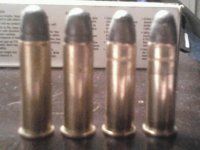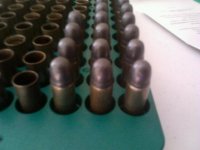Doug.38PR
Member
Hello all,
I just got into reloading about a year ago. been reading, taking my time, slowly going through each step.
Here is the first batch. .38 Special, with Winchester Small Pistol primers, Speer 158 gr LRN bullets, cartridges loaded with 4.0 grains of Unique.
I crimped them by eyeballing some Buffalo Bore LHP rounds I had in my gun and a few Remington white box LRN rounds I found in my drawer.
The one on the far left are two reloads Speer LRN (left) next to two Remington factory LRN (right)
The one on the far right is the original of the batch
What do y'all think?
I just got into reloading about a year ago. been reading, taking my time, slowly going through each step.
Here is the first batch. .38 Special, with Winchester Small Pistol primers, Speer 158 gr LRN bullets, cartridges loaded with 4.0 grains of Unique.
I crimped them by eyeballing some Buffalo Bore LHP rounds I had in my gun and a few Remington white box LRN rounds I found in my drawer.
The one on the far left are two reloads Speer LRN (left) next to two Remington factory LRN (right)
The one on the far right is the original of the batch
What do y'all think?
Attachments
-
 312877_10150342128660116_555290115_7901873_244417550_n.jpg45.2 KB · Views: 303
312877_10150342128660116_555290115_7901873_244417550_n.jpg45.2 KB · Views: 303 -
 314435_10150341968765116_555290115_7901113_1961076204_n.jpg49.7 KB · Views: 209
314435_10150341968765116_555290115_7901113_1961076204_n.jpg49.7 KB · Views: 209 -
 299732_10150341794715116_555290115_7899786_2053703384_n.jpg36.9 KB · Views: 225
299732_10150341794715116_555290115_7899786_2053703384_n.jpg36.9 KB · Views: 225 -
 311329_10150341768405116_555290115_7899489_311242068_n.jpg14.9 KB · Views: 243
311329_10150341768405116_555290115_7899489_311242068_n.jpg14.9 KB · Views: 243
Last edited:
